![]() Although email has evolved and matured to the point where is essentially ubiquitous, I continue to be amazed at how little attention is paid to how to incrementally measure and improve the results – particularly since the entire process is incremental. There is an all too common, but nonetheless stunning, lack of interest in the financial results from email campaigns. It’s not clear if that lack of interest comes from the false perception that email is automatic, it’s not needed, or some other reason – but the frequency that email is not properly managed is surprising.
Although email has evolved and matured to the point where is essentially ubiquitous, I continue to be amazed at how little attention is paid to how to incrementally measure and improve the results – particularly since the entire process is incremental. There is an all too common, but nonetheless stunning, lack of interest in the financial results from email campaigns. It’s not clear if that lack of interest comes from the false perception that email is automatic, it’s not needed, or some other reason – but the frequency that email is not properly managed is surprising.
Customers are talking to us, all the time. Customers are telling us what and how to sell to them. Shareholders expect us to hear and act on that. For instance, here is an example of adding an incremental $1 million to email’s top line and it is dependent on listening to customer behavior. For this example, we are going to focus on revenue, the statistical measure that practitioners use to drive continuous improvement and revenue per email, also known as RPE, which is what managers use to evaluate their campaigns.
Starting Point
First, let’s start with some assumptions for a scenario. In this scenario, assume the mail volume is 575 million. The Open rate is 15%, the click-to-open rate is 5.5%, and the transaction-to-click rate is 3.2%. The Average Order Value is $75.23 and the revenue per e-mail is two cents ($0.020.)
Revenue: $11.5MM
Management metric: RPE $0.020
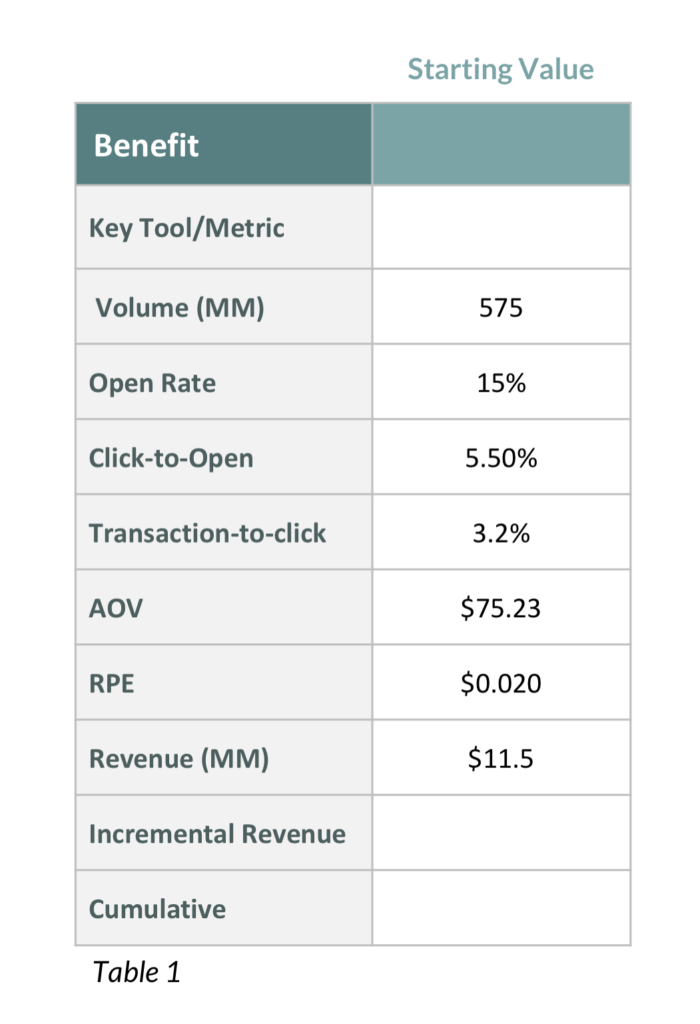
1. More with Less: Clean up your List
Remove junk
The first thing we are going to do is “do more with less” and optimize the “Send Process.” We get less by utilizing a manual and rudimentary master data management (MDM) and targeting. Customer Databases are notoriously dirty; particularly for those companies that require and or incent their associates to capture and add customer emails without any type of front end entry validation or verification technology. A quick test for your database is to ask your analysts for a count of Santa Claus, Buddha (or any other deity) George Washington (who knew the father of our country had email,) various and sundry war criminals, vulgar names for body parts, and other words that you can only imagine. These “names” waste time, effort, and money for everyone that touches them. But mostly they distort every financial measure you attempt to derive from the database. With this kind of junk in the customer file, generalizations become difficult to make and risky when they are made.
Send to one email per customer
Another quick check for your database is multiple emails addresses for the same person. Sending an email to every email you can possible capture from customers is not providing multiple exposures, it’s SPAMing and when you do that, your customers unsubscribe or even worse report it as junk, of which the long-term opportunity costs is non-trivial. Multiple emails to the same person also distorts the real metrics required to properly manage any kind of email profit center. It distorts every meaningful lever meaning you can’t make confident inferences on the outcomes of actions you want to make to improve financial return.
When you lose a customer that you’ve SPAMed you’ve lost them forever – and that is a long time, and if you believe time is money; using a two cents revenue per email metric and a 1% opt-out rate you have cost your shareholders $115 thousand from their top line each time you drop a mailing.
Eliminate inactives and unlikelies
Next, we are going to deploy ridiculously rudimentary targeting to eliminate those customers that have virtually a zero chance of opening their email. The customer that has not opened an email in the last, say, 6 months, is not likely to open the one in the queue to be sent today. The customer that has purchased only costume jewelry earrings, inexpensive lipstick, and romance novels is not likely to overly interested in that great deal on lawn tractors with a free trailer. Although there is a remote possibility that the likely young woman is indeed interested in a John Deere lawn tractor with a free trailer, the more likely outcome is a rule for junk being engaged or an unsub request, in which case you’ve lost future revenue.
At this point, we’ve lowered the risk of unsubs and increased the RPE. (See Table 2) We did that by using a rudimentary MDM to identify 5% of the mail volume that were dupes and another 5% of the mail volume that were almost guaranteed to not open or respond. Depending on your cost structure with your ESP you have may have saved up to $100K on outbound mail volume expenses. But most importantly, the junk data in the database has been reduced and the confidence that can be assigned to any extrapolated assumptions on performance has increased.
Revenue: $11.5MM
Management metric: RPE $0.022
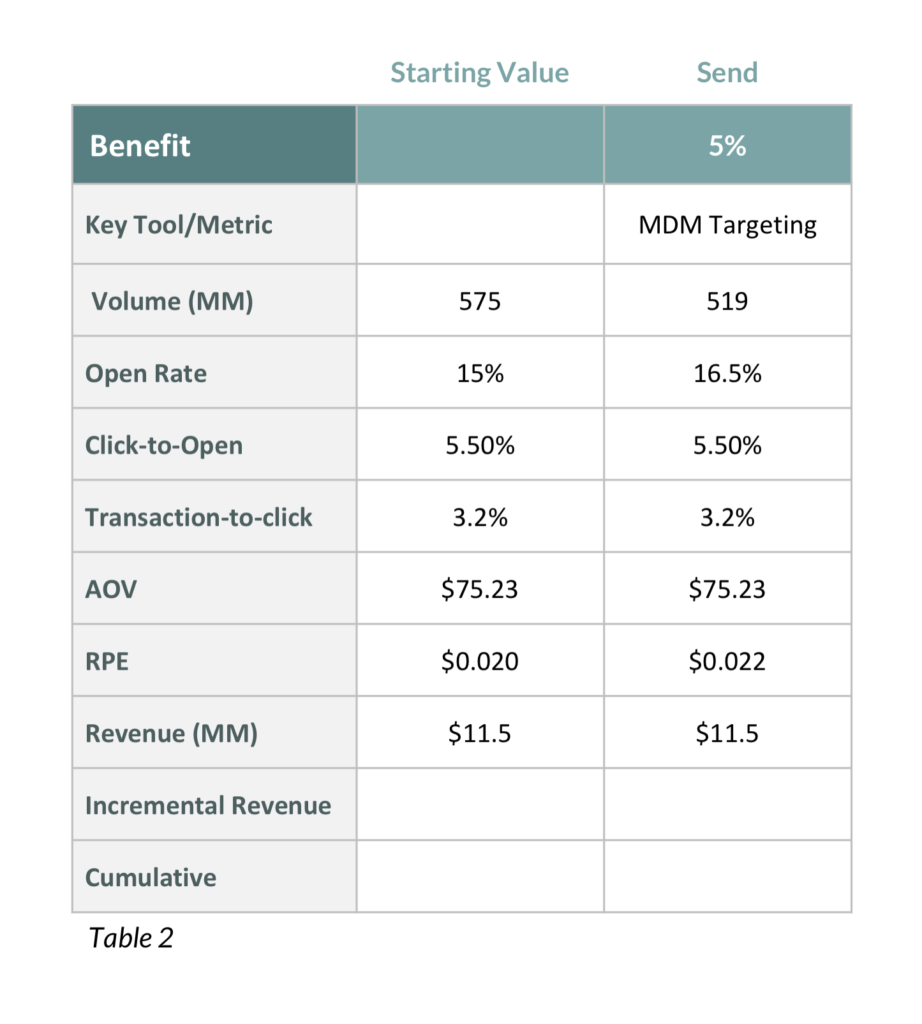
2. A/B Test Subject Lines
An email that is not opened contributes no value to the Company. So, the next point of optimization is Subject Lines. We need to get the recipient to open our email and the best way to do that is through the subject line. Other than the sender’s name, nothing is more obvious about an email that the subject line. Almost all ESPs have tools and processes that allow you to execute an A/B test strategy. Most provide a short lead-in period during which response rates are immediately and interactively published providing for a preference to be made for the remainder of the mail file. More exhaustive test results are available if you split your mailing into several independent waves and run multiple A/B tests. Response analysis will provide the best performing overall subject line for the next outbound effort and for the next champion challenger testing with the ESP. Let’s assume you can increase the open rate by 2%. This small increase is open rates yields hundreds of thousands of dollars. In our example with just over 500 million emails, we are looking at an incremental $229 thousand. (See Table 3)
Revenue: $11.7MM
Management metric: RPE $0.022
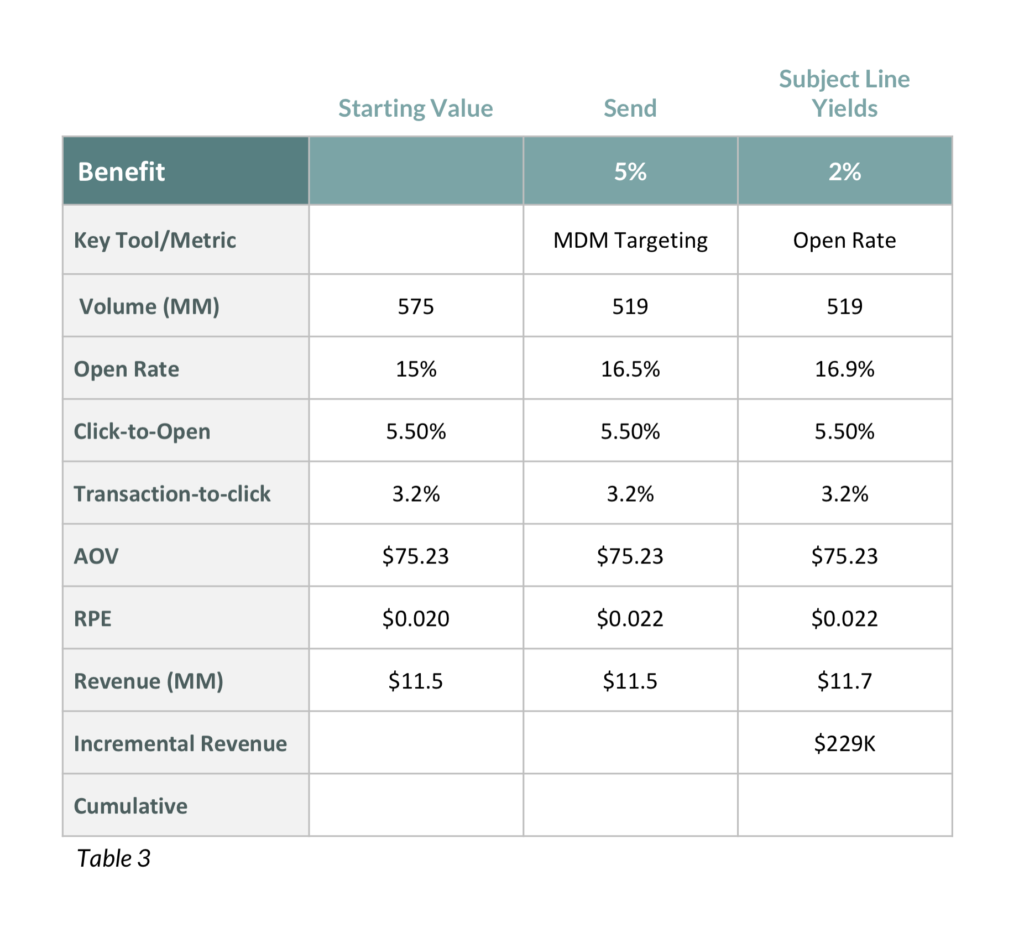
3. Content Personalization and Click-to-Open
Once the email is opened, what do you want the customer to do? You want them to take some action – probably clicking through to the site to make a purchase or take some other action. You do that by being relevant. Not everyone is interested in inexpensive lipstick or lawn tractors and if you want your email to be successful and profitable, it is required that you have at least a chance that the person to whom you are talking is interested in what you are talking about.
You can understand specifically in what your customer is interested in using the characteristics of past purchases and occasionally by appended demographics. By being relevant and personalizing your email, your click thru activity increases. For this example, we are going to assume a small 1.5% increase in click thru activity, keep all other ratios constant, and realize a $400K revenue bump. (See Table 4)
Revenue: $11.5MM
Management metric: RPE $0.0232
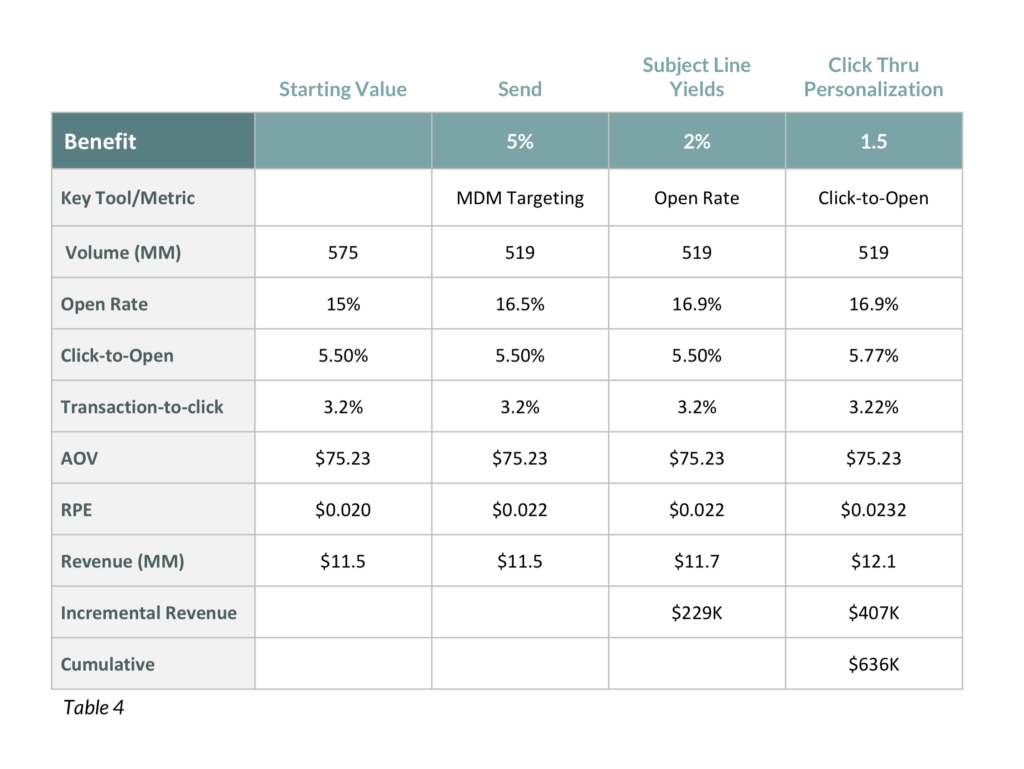
So far we’ve generated well over a half million in incremental revenue and have only made a few simple changes in an email: eliminating those emails that will have no chance of response and used information the customers have given us to understand them better and speak to them in a more personalized and relevant way.
4. Website Personalization and Transaction-to-Click
The next thing we need to do is optimize the site for the incoming click. If your customer is clicking through an email that has highlighted shirts, use the data you have about shirts the customer has purchased in the past and shirts that those customers like the one clicking through have purchased in the past and show those shirts. Taking the customer that has just clicked through to a page with stiletto heels, hiking boots, dumping them onto a home page dramatically reduces the likelihood of closing the deal.
However, you can continue the personalization onto the site, which is imminently possible assuming a basic real-time customer database and warehouse is in place, the likelihood of closing the deal increases. In this scenario, we are assuming that keeping personalization active through to the site will slightly increase purchases by 2%. That increase adds another $240 thousand in revenue and a cumulative total of almost $900 thousand. (See Table 5)
Revenue: $12.3MM
Management metric: RPE $0.0237
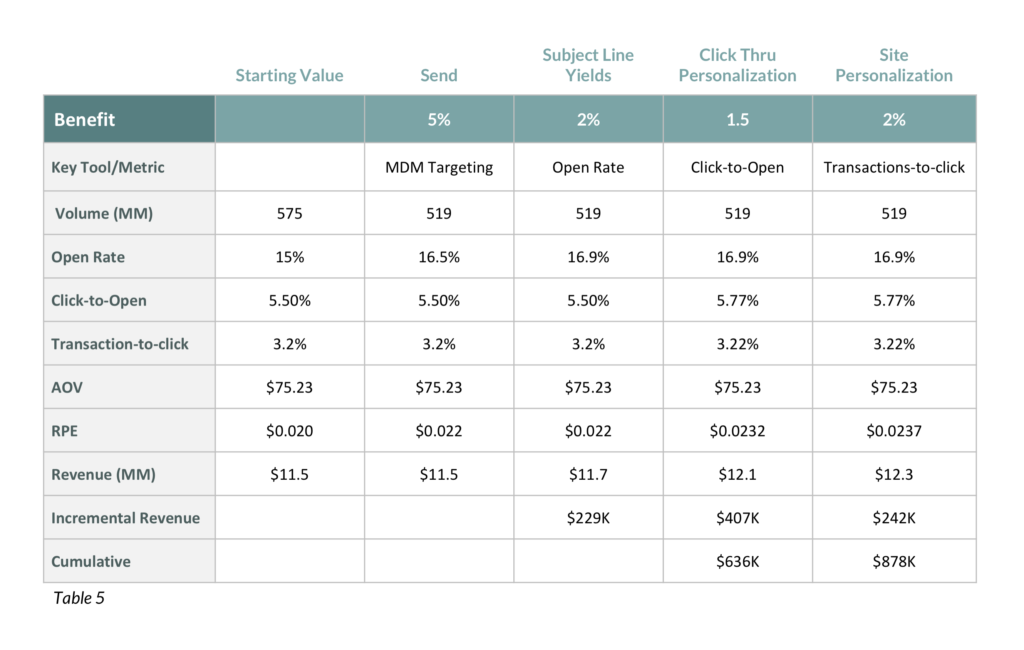
5. Personalized Product Bundles and Offers
Now, it’s time to hand the baton to the site for further personalization and response to browse behavior. Using all the customer data in the real-time customer database and warehouse and immediate browse behavior, the site can interactively make relevant combinations of products and offers to close the deal. Assuming these product combinations were derived from empirical customer observations we can assume a small 1.5% increase in AOV from site activity. That small increase yields an incremental $245K in revenue which cumulatively puts us over the million dollar target we set for ourselves. (See Table 6)
Revenue: $12.6MM
Management metric: RPE $0.0242
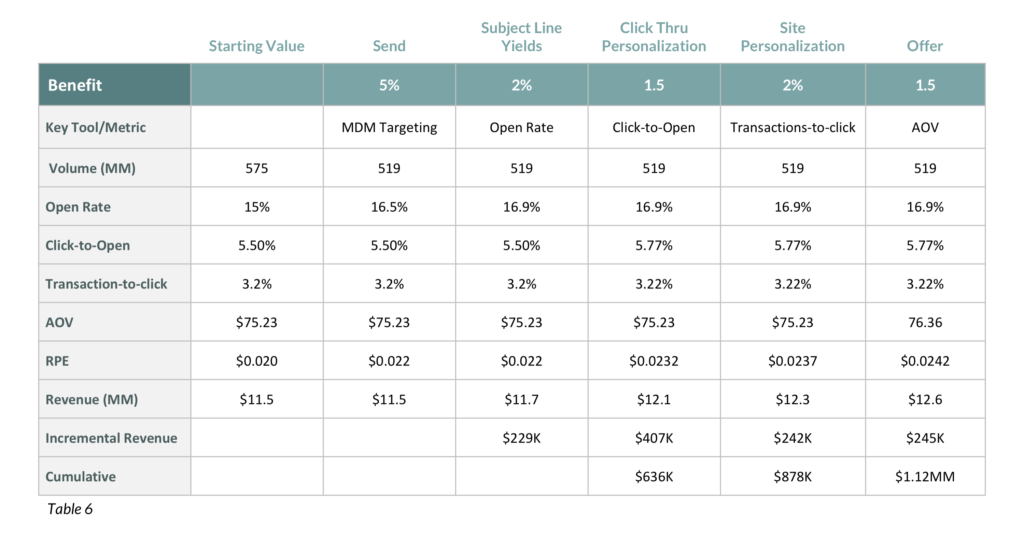
Summary and Challenge
There are those that say the stock market is a perfect measure of the worth of a company. It’s been said that the perfect measure of a performance of a CEO of a public company is the share price and some believe market share and customer value are the key performance indicator for a CMO. Just as those measures may not be perfect, they are consistent, reliable, and even though we are cautioned against using them as a way to make assumptions about the future, we all do it.
Email has a similar metric: RPE – Revenue per Email. It is consistent if you have a good junk free database, it is reliable, and it can be used to make assumptions about the next email campaign. Marketers do not need to focus only on volume, indeed volume becomes one of several leading indicators that allow for efficient optimization for revenue and profit, not a never ending and exhausting need to constantly feed the email machine with new addresses.
Now, if you can get to a million incremental dollars with a few simple improvements, imagine what benefit is available from a program of continuous improvement including a formal MDM installation, close analysis of open behavior, continuous subject line testing, and including all known customer data into a formal predictive modeling environment. The shareholders deserve it.
Share this Post
